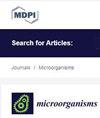The Impact of Rhizospheric and Endophytic Bacteria on the Germination of Carajasia cangae: A Threatened Rubiaceae of the Amazon Cangas
IF 4.1
2区 生物学
Q2 MICROBIOLOGY
引用次数: 0
Abstract
Carajasia cangae (Rubiaceae) is a narrow endemic species from the canga ecosystems of the Carajás National Forest that is facing extinction due to a limited range and habitat disturbance from hydroclimatological changes and mining activities. This study examines the influence of rhizospheric and endophytic bacteria on C. cangae seed germination to support conservation efforts. Soil samples, both rhizospheric and non-rhizospheric, as well as plant root tissues, were collected. Bacteria from these samples were subsequently isolated, cultured, and identified. DNA sequencing revealed the presence of 16 isolates (9 rhizospheric and 7 endophytic), representing 19 genera and 6 phyla: Proteobacteria, Actinobacteria, Acidobacteria, Firmicutes, Bacteroidetes, and Chloroflexi. The endophytic isolates of Bacillus and the rhizospheric isolates of Planococcus and Lysinibacillus reduced the median germination time and initiation time, while the rhizospheric isolates Serratia and Comamonas increased the germination time and decreased the germination percentage in comparison to the control sample. These findings emphasize the crucial role of endophytic bacteria in the germination of C. cangae and highlight isolates that could have beneficial effects in the following stages of plant growth. Understanding the impact of endophytic and rhizospheric bacterial isolates on seed germination can enhance conservation efforts by shortening the germination period of this species and thereby improving seedling production. Additionally, this knowledge will pave the way for future research on the role of bacteria in the establishment of C. cangae.根瘤菌和内生菌对 Carajasia cangae 发芽的影响:亚马逊坎加斯濒危茜草科植物
Carajasia cangae(茜草科)是卡拉哈斯国家森林苍术生态系统中的一种狭长特有物种,由于分布范围有限以及水文气象变化和采矿活动对栖息地的干扰,该物种正面临灭绝。本研究探讨了根瘤菌和内生菌对苍术种子萌发的影响,以支持保护工作。研究人员采集了根瘤菌和非根瘤菌的土壤样本以及植物根部组织。随后对这些样本中的细菌进行了分离、培养和鉴定。DNA 测序结果显示有 16 个分离菌(9 个根瘤菌和 7 个内生菌),分别代表 19 个属和 6 个门:它们分别代表 19 个属和 6 个门:蛋白质细菌门、放线菌门、酸性细菌门、真菌门、类杆菌门和绿藻门。与对照样本相比,芽孢杆菌的内生分离物以及 Planococcus 和 Lysinibacillus 的根瘤分离物缩短了中位发芽时间和起始时间,而根瘤分离物 Serratia 和 Comamonas 则延长了发芽时间并降低了发芽率。这些发现强调了内生细菌在苍耳发芽过程中的关键作用,并突出了在植物生长的后续阶段可能产生有益影响的分离物。了解内生细菌和根瘤细菌分离物对种子萌发的影响可以缩短该物种的萌发期,从而提高幼苗产量,从而加强保护工作。此外,这些知识还将为今后研究细菌在苍术的生长过程中的作用铺平道路。
本文章由计算机程序翻译,如有差异,请以英文原文为准。
求助全文
约1分钟内获得全文
求助全文
来源期刊

Microorganisms
Medicine-Microbiology (medical)
CiteScore
7.40
自引率
6.70%
发文量
2168
审稿时长
20.03 days
期刊介绍:
Microorganisms (ISSN 2076-2607) is an international, peer-reviewed open access journal which provides an advanced forum for studies related to prokaryotic and eukaryotic microorganisms, viruses and prions. It publishes reviews, research papers and communications. Our aim is to encourage scientists to publish their experimental and theoretical results in as much detail as possible. There is no restriction on the length of the papers. The full experimental details must be provided so that the results can be reproduced. Electronic files and software regarding the full details of the calculation or experimental procedure, if unable to be published in a normal way, can be deposited as supplementary electronic material.
 求助内容:
求助内容: 应助结果提醒方式:
应助结果提醒方式:


